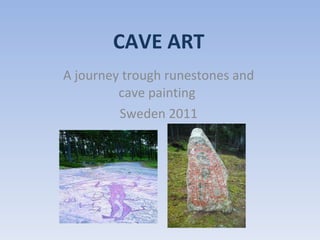Our Visit in Sweden: Runestones
- 1. CAVE ART A journey trough runestones and cave painting Sweden 2011
- 2. RUNESTONES A runestone is a raised stone with a runic inscription. The first stones were probably made in the 4th century, and the last in the 12th century, but most of the runestones date from the late Viking Age. Most runestones are in Scandinavia. Runestones are often memorials to dead men. They were usually brightly colored when erected, but the colour has worn off now.
- 3. Sm 55 Sm 55 is situated in the Sm├źland area, near J├Čnk├Čping, where the Fenix School is. It stands more or less in its original place, but has been turned, as originally the inscription faced south, while now it faces west-southwest.
- 4. The inscription seems very clear and well made. However it is difficult to understand it. Many think it does not make much sense. Maybe the person who made the stone was ignorant or poorly skilled in the art of writing and reading runes, maybe it is written in dialect that is no longer understandable.
- 5. This picture was taken by an Italian student during the trip to Sweden .
- 6. PETROGLYPHS Petroglyphs (also called rock engravings) are pictogram and logogram images created by removing part of a large rock surface by abrading it using a smaller stone.
- 7. Petroglyphs are found worldwide, and are often associated with prehistoric peoples. The word comes from the Greek words Petros = stone + Glyphein = to carve and it was originally a French word, p├®troglyphe .
- 8. VITLYCKE MUSEUM In the area around the Vitlycke Museum there is one of the biggest painted stones in Sweden.
- 9. The rock shows war scenes, hunting scenes, ritual celebrations and daily life. a man ŌĆō you can understand it because he has a penis and is holding a spear a woman ŌĆō look at the ponytail a ship animals
- 10. Sometimes petroglyphs are difficult to see if they have not been coloured. We used carbon paper to make them appear on white paper. Alessia, Beatrice, Chiara









